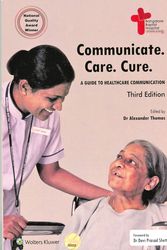Words can cut deeper than a scalpel, and sometimes no suture can close those wounds.
Doctors have come to realise the power of words and effective communication in health care over a period of time. “My aim was to become a perfect operating machine and, in that plan, interacting with the patient did not matter at all, since surgical skill was the only thing that was important,” writes Dr Devi Shetty, chairman, Narayana Health, in the foreword of Communicate. Care. Cure. Though legally bound to interact with patients and to take their consent before surgery, he saw it as a mere formality. “However, when I started work in Kolkata, I would see nearly 100 patients a day, but hardly anyone turned up for an operation,” he recalls. “This made me realise the importance of effective communication.”
Edited by Dr Alexander Thomas and Divya Alexander, Communicate. Care. Cure. dissects the many ways of communication in hospitals—a complex setting that involves various stakeholders. A first-of-its-kind book that focuses on health care communication, it offers practical solutions to breakdown in communications, with each chapter addressing the challenges faced by patients, their kin, health care providers, administrators and support staff.
And, it is not just about verbal communication. Gestures matter, too—we have all been to that doctor who refuses to make eye contact while listening to our litany of discomforts. Listening, the book states, is important for good communication, as is paying attention to nonverbal cues. The book cites an instance of a nurse detecting the anxiety of a young cancer patient through his artwork, and changing his care plan accordingly.
The chapter that touches a deeper chord though is on breaking bad news to patients. In the medical profession, states the book, there is no way to avoid this task. And, it is not as simple as mouthing a filmi dialogue—“inko dawa ki nahi, dua ki zaroorat hain [he needs prayers, not medicine].”—and moving on. The doctor has to compartmentalise his own emotions and discuss every aspect of the illness and treatment with the patient and his family, and be kind and not too clinical about it. Grace under pressure, they say. There is another chapter that addresses the elephant in the room—medical errors—and details how and when to apologise.
The book was first published in 2012, and opened up discussions on the impact of communication on the quality of care. Now in its third edition, which came out this year, it has two new chapters—on communication for nurses and for medical students. It is interesting to note that it was only this year that a module on attitude, ethics and communication was included in the curriculum of medical colleges.
As the chapters are written by health care professionals, from nurses and doctors to administrators and policy makers, various voices come through. And, the writers stay true to the advice they give: no jargon. Each chapter is illustrated with examples and has a ‘take-home message’ at the end. Since the theme is communication, there are certain points, though they need to be emphasised, that are repeated across chapters. A few repetitions could have been avoided or kept short. The book, however, effectively communicates the message it sets out to give, and lives up to its title and more.
Communicate. Care. Cure. A Guide to Healthcare Communication
Edited by Dr Alexander Thomas
Published by Wolters Kluwer (India) Pvt Ltd
Pages: 234; price: Rs499



